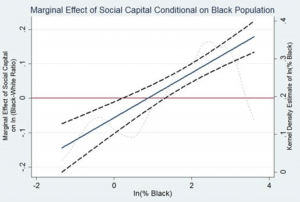How Social Capital Impacts Racial Disparities in Incarceration
How Social Capital Impacts Racial Disparities in Incarceration
Link: https://blogs.lse.ac.uk/usappblog/2017/09/22/white-middle-class-social-capital-helps-to-incarcerate-african-americans-in-racially-diverse-states/
As individuals form connections with each other that build up to networks, they create social capital as they maintain these relationships. Social capital is generally regarded as a positive thing, as it encourages support within communities and encourages empathy. It can also serve as a social lubricant that helps society function more smoothly. In the case of criminal sentencing, social capital can create social empathy that can lead to less harsh sentencing for criminals. However, many often fail to consider the factor of race when considering the impact of social capital on incarceration rates. In fact, research has shown that while social capital can reduce racial disparity in incarceration rates in states with few African Americans, it can actually lead to greater targeting in states with a more abundant African American population. In the article “White, middle-class social capital helps to incarcerate African-Americans in racially diverse states” from a blog from the London School of Economics, recent research has found that because there is tension between racial and ethnic diversity and social capital, the effects of social capital in society may actually increase racial inequality. For example, in the United States, African Americans make up 37% of the prison population while only making up 13% of the US population. Additionally, Black men are seven times more likely to be incarcerated than white men of a similar age.
There are two theories on how social capital may influence incarceration rates. Generally, social capital can increase social empathy, which may make people more likely to support lower sentences or rehabilitation programs instead of harsh sentences. On the other hand, social capital can also increase the level of social controls in society. This means that people have less tolerance for rule-breakers because they are breaking social norms, which leads to higher incarceration rates. Placing this idea into the context of race, if we have a community with high social capital, there exists a high sense of community and civic engagement within the community. Therefore, the community members more carefully monitor and report “suspicious” activity. As a result, a Hispanic or African American man walking in the neighborhood may be more likely to be reported to the police as “suspicious”.
In the graph above, we can see that in states with a low African American population, social capital is actually associated with reducing the black-white disparity in incarceration rates. However, as the African American population in a state increases, social capital actually begins to increase those disparities. This means that social capital can work in two ways – enhancing social trust and empathy or enhancing social controls and punishments for those that break the norm.

